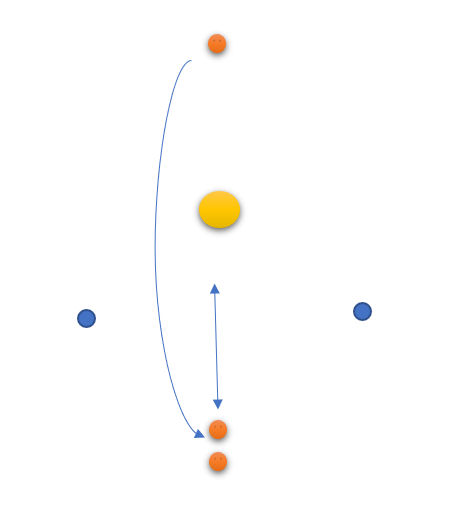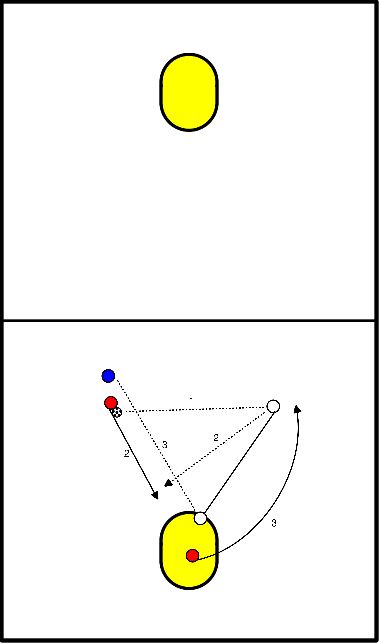Korfball exercises for u22
- Players stand in front of each other and each has a ball in one of their hands.
- One in their left hand, the other in their right hand.
- Now they are going to throw the balls to each other
- ...so for a certain period of time or for several times
- A player stand with the ball well behind post
- Attacker with defender in front of the post
- Attacker must always run towards the line of pilons after a shot
- Then wait until the passer throws the ball so he can run backwards and shoot
- Switch after a goal
- Pressure:
- Defender runs slowly with the attacker
- Defender 75%
- Defender full pressure
- Pressure:

- Shooter with a defender in front of the post.
- Passer with defender behind the post.
- Passer throws long ball at shooter and takes rebound.
- Shooter may pass an x on defender rebounder
- When defender jumps in, rebounder steps out for a breakthrough.
- 4 versus 4
- Men come into a supportive position to let the men score.
- Option 1: Positions under the post are filled by 1 lady and 1 man.
- Option 2: Positions under the post would be filled by 2 ladies.
- Option 3: Play in 3:1 ratio
- Ladies would play side by side, one for the breakthrough and the other for the shot.
BRIDGE
Starting position
- Lie on your back.
- Bend your knees 90 degrees and put both feet flat on the ground.
- Your arms lie along your body with your palms down.
Action
- Tighten your buttocks and belly.
- Lift your buttocks off the ground to form a straight line with your knees, hips and shoulders.
Difficulty
- To add increase the difficulty of this exercise, stretch your right and left legs alternately, keeping your hips in position.
- Pilon 1
- Tap the ground 6 times and jump up and stretch out all the way. RUN TO POST 1.
- Post 1
- then you take a dodgeball at post 1.
RUN TO PAWN 2.
- then you take a dodgeball at post 1.
- Pilon 2
- jumping lunge
RUN TO POST 2.
- jumping lunge
- Post 2
- take a through-ball at post 2.
Run to a pilon
- take a through-ball at post 2.
- Pilon 3
- 6x push-ups
RUN TO POST 3.
- 6x push-ups
- Post 3
- short chance behind the post
RUN TO PAWN 4.
- short chance behind the post
- Pilon 4
- 6x squad
RUN TO POST 4.
- 6x squad
- Post 4
- dodge to the other side
Run to PAWN 1
- dodge to the other side
- This is repeated 5 times
- but change every time under the post.
! Form groups of 2 persons per post
Each group gets three playing cards. The cards are shuffled from the front and the numbers 2 to 5 are removed from the pack. With the three playing cards the groups have to get as close as possible to 31. The value of the numbers and pictures are shown below:
- Six = six
- Seven = seven
- Eight = eight
- Nine = nine
- Ten = ten
- Jack = ten
- Queen = ten
- King = ten
- Ace = eleven
So nine + jack + queen = 29 points or ace + jack + queen = 31, but you can also have jack + jack + jack = 30.5
Once players have completed a series, they may exchange one of their received cards for a new one, in order to get closer to 31. The trainer will set a timer and says when to stop. The team closest to 31 wins.
Series:
1. through-balls: five goals in a row.
2. through-balls: 5 goals in a row from behind the post.
3. Play through-balls by going for the short chance, 3 times in a row.
! Make groups of 3 and let the players divide themselves in person 1, 2 and 3. After two rounds, change one person.
- Form groups of 3 at the post.
- Person 1 stands 6 meters in front of the post at the pilon,
- person 2 will stand 6 meters behind the post at the pilon.
- Person 3 stands under the post as a receiver.
- Person 1 starts with e.g. taking a though-ball, then goes back to the pilon.
- Person 2 takes a through-ball, as person 3 has caught the ball. This is how you perform all the exercises.
Exercises:
- Through-ball
- Dodge ball right
- Dodge ball left
- Turnaround-ball past the post
Groups of 3 change 1 by 1
Groups of 4 change 2 by 2
- At pilon 1
- 1 time up and down, sideways with small steps between the pilons.
- RUN TOWARDS POST 1 for a through-ball.
- At pilon 2
- 5 sit-ups.
- RUN TOWARDS POST 2 for a dodge ball (minimum 5 meters).
- At pilon 3
- again 1 time up and down between the pilons with small steps
- RUN TOWARDS POST 3 tap the post and take a short chance.
- If you have 5 points, you can change, only the shot counts for 2. (From post 3 to pilon 1 an interval for seniors with running at slow pace and sprinting.)
- Taking through-balls.
- Passingis well ahead.
- One time the passer does nothing.
- The other time it tries to block.
Attention: The penalty taker stays calm and remembers to fully extend...
- Red plays the ball to white and runs through.
- White plays the ball immediately becomes receiver.
- Red runs to the spot of white and white plays the ball to blue etc,

- A passer under the post with ball, a receiver behind the post and the attackers in front of the post at about eight metres.
- The attacker takes a distance shot while randomly in motion to the left or right.
- The passer joins the attackers, the receiver becomes the passer and the attacker becomes the receiver.
What can you see?
- Role rotation takes some getting used to.
- Not every player knows where to shoot from.
- Players have difficulty to estimate where the ball will be played.
- Throwing to a running attacker is inaccurate.
- Timing of the attacker's posture before the shot. posture becomes right when the shooter is standing still when the ball is caught. Standing means: standing in the direction of the post, nose and belly button pointing towards the post and feet are in a light spread position.
- Capturing the ball at the shooter's is done in two stages, first the shooter wants to get the ball, then the ball is taken firmly into the hands in order to release a shot. It is only good if, after catching the ball, a shot can be immediately thrown. Therefore, make sure that the hands are in the correct catching position before the shot is fired.
Variation 1:
- As a previous exercise, but after the shot, the shooter waits for the ball to be caught and takes a through-ball.
- The receiver also catches the through-ball.
What can you see?
- Waiting patiently after the shot, while the shooter is in motion, is difficult for the shooter because the concentration already goes to the through-ball. The shooting is then just a turn and not an attempt to score. Concentration of the shot also means following the ball after it has been released.
- Capturing the shot, playing the through-ball and catching the through-ball will result in malfunctions.
Variation 2:
- As a previous exercise, but before the shooter takes the through-ball, he receives the ball, makes a feint shot, throws back to the passer with one hand and only then takes a through-ball.
- A feint shot means that the initial starting position of a shot is taken, the arms are stretched but the ball is not released.
- Instead, the shooter throws back to the passer with one hand.
- The choice of left or right often depends on the position of the defender, this is dealt with in the next exercise.
Variation 3:
- As the previous exercise, but the 1st passer does not immediately join the attackers.
- After the shooter's first shot (this shot remains without an opponent), the receiver will throw the ball at the shooter.
- At that point, the first passer becomes a defender to block the (false) shot.
- The shooter passes the defender and takes the through-ball.
- The defender now joins the attackers.
What can you see?
- Through a lot of examples and patient practice, the form becomes controlled.
- The feint shot is skipped, as soon as the ball is received, the hands are placed inside. Emphasise the feint shot to fool the opponent.
- Throwing in is not done accurately and not with one hand.
- The number of goals may be disappointing in the beginning because there is a lot of concentration on the form of the exercise. Especially the right choice to pass the defender is important, that this is initially at the expense of the score is acceptable.
- The defender must be attentive to avoid collisions.
- The defender can use his hands to block the pass inwards. This leads to new difficulties for the attacker. Phase the pressure exerted by the defender (e.g. with two hands on the back, then use one hand, jumping in and only defending fully on the shot).








